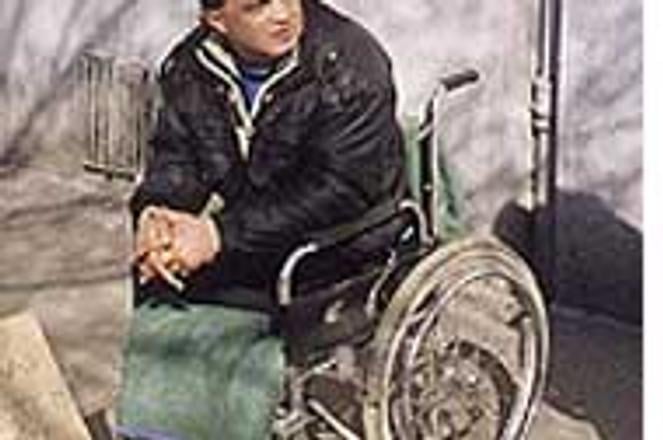Rasťo Holúbek, a 28 year-old former lumberjack, defies the popular image of beggars as drunks and frauds.photo: Peter Barecz
Rasťo Holúbek is a part of a new phenomenon in Slovakia - he's a beggar. Four years ago, he was beaten up an robbed by a gang of drunk men, and then flung in front of a passing train. He lost both legs in the accident, and his wife and daughter a few months later when they walked out on him. These days he can be found in a wheel chair on one of Bratislava's busy streets, begging money from passersby to pay for a pair of prostheses.
There aren't many beggars in Slovakia by Western standards - police estimate that around 50 panhandlers work the streets of the capital during the summer months, while regional cities like Košice and Banská Bystrica are home to about 15 mendicants each.
But what may shock foreigners is the abject condition of Slovakia's beggars. Many, like Holúbek, display maimed limbs and digits. Most crouch to the ground in prayer, their faces brushing the pavement even on the coldest, wettest days. According to Holúbek, it's a tough job coaxing donations from the country's suspicious, hard-up citizens.
Sociologist Zuzana Kusá agreed that Slovaks regarded mendicants and the whole act of begging with deep reserve. Begging was unknown during communism, and as it became more common during the 1990's, media reports accusing beggars of being drug addicts and alcoholics making thousands of crowns a day encouraged people to dismiss them as frauds.
"If there is a report on TV saying that all beggars are addicts and alcoholics, and exaggerating how much money they reportedly make, it immediately changes people's attitudes," Kusá said.
Her words were borne out by Alica Čapčíková, a 68 year-old pensioner from Bratislava. "I never give them [beggars] money," she said as she was getting ready to enter a downtown church. "They never buy food for it. There is one Roma begging near my flat, and when I meet him he is always drunk. I also heard on television that they were organized [by mafia groups] and that they were making a huge 10,000 crowns [$240] a month. That's almost three times my pension."
Last month, the Slovak media carried reports of two fraudulent wheelchair beggars who were asking for money under false pretences - a Trnava man who claimed to be paralysed from the waist down but had mud on his shoes, and a Banská Bystrica woman who admitted she had no disability requiring her to use a wheelchair.
"These people are just using emotional blackmail to get money," said Marta Heinrichová, a 23 year-old student from Žilina. "I never give them anything, because I think there are other ways to get by if you're poor. It's not normal."
The claims of beggars to public welfare have also been discredited by widespread rumours that begging is a profession 'organised' by mafia thugs who collected money from the mendicants under their 'care'. Jozef Valčuha, the deputy chief of the Banská Bystrica city police, said that police had uncovered evidence to support this theory. "One man used his car to bring five beggars into the city every day, and we had indications he was taking commissions from them," he said. "But we weren't able to prove anything."
Holúbek said that he too had been approached for a 'commission', but had refused. "Two men came to late in the afternoon and asked me to give them part of my money. I told them to get lost and they left me. They try to do this with every beggar, and if they see you are weak and don't protest, of course they will take advantage of you."
But aid workers who help beggars re-enter society say that a few bad apples are ruining the public image of Slovak beggars. Katarína Rašlová, who runs the Bratislava Catholic Charity soup kitchen, said some homeless people were bullying weaker or disturbed beggars into giving them money. "Many of them are former convicts, many are alcoholics who lost their homes and live in canals. But it would not be fair to say that all homeless and beggars are like that," she said.
Sociologist Kusá, meanwhile, said that economic conditions might be behind the disapproval of begging expressed by many Bratislavans. In the capital, she explained, unemployment was little over 6%, and the city's working population saw no reason why anyone would have to beg rather than work for a living. "In cities like Bratislava, it's easy to find work and people who work hard are naturally against begging," Kusá said. "But in areas of high unemployment, people tend to show more tolerance to beggars, especially since they know very well how difficult it is to survive on the minimum monthly welfare payment of 1,450 crowns [$34]."
Whatever the source of the general public disapproval, Rašto Holúbek said he made enough from panhandling to get by and even save for a new pair of prostheses.
"I started begging two years ago," he said. "I want to walk again, and the insurance will only give me 50,000 crowns [$1,200] for the prostheses. But they cost about 700,000 crowns [$16,300]."
Holúbek said he made about 500 crowns a day on the streets, money he supplemented by painting portraits and landscapes. "I've heard stories that some beggars make much more," he said, adjusting himself in his wheelchair. "But I don't know whether they are true or not."


